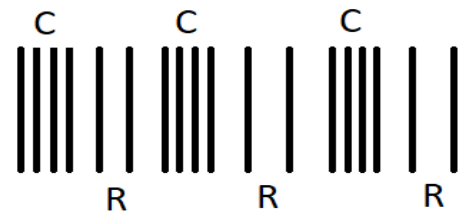
A progressive sound wave of frequency \[500Hz\] is travelling through air with a speed of $350m{s^{ - 1}}.$ A compression maximum appears at a place at a given instant. The minimum time interval after which the rarefaction maximum occurs at the same point, is:
A) $200s$
B) $\dfrac{1}{{250}}s$
C) $\dfrac{1}{{500}}s$
D) $\dfrac{1}{{1000}}s$
Answer
180k+ views
Hint: To solve this question, first, we need to find the time period of the sound wave and then assume the time interval between the rarefaction and the compression will be the minimum time interval after which the rarefaction maximum occurs at the same point at which the compression took place.
Complete step by step answer:
Let’s define all the terms given in the question:
Frequency of the sound wave, \[f = 500Hz\]
Speed of the sound wave, $v = 350m{s^{ - 1}}.$
The sound wave creates compression and rarefaction on the medium through which it propagates. The compression and rarefaction occurs alternatively.
In the compression region, the medium will be in a compressed form and in the portion of rarefaction, the medium will have a spread out form. The position of the particles do note change but vibrates, and the wave travels from one position to another.

We know the time taken for a compression to compression ($C \to C$ in the figure) and rarefaction to rarefaction ($R \to R$ in the figure) is the same and which is taken as $T$
The period of the wave, $T = \dfrac{1}{f} = \dfrac{1}{{500}}$
The minimum time interval after which the rarefaction maximum occurs at the point at which the compression maximum ($C \to R$ in the figure) will be equal to
$\dfrac{T}{2} = \dfrac{{\left( {\dfrac{1}{{500}}} \right)}}{2}$
$ \Rightarrow \dfrac{1}{{500 \times 2}} = \dfrac{1}{{1000}}s$
The minimum time interval after which the rarefaction maximum occurs at the same point at which the compression took place, is
$\dfrac{1}{{1000}}s$
The final answer is option (D), $\dfrac{1}{{1000}}s$.
Note: Sound needs a medium for their propagation like solid or fluid to travel because the molecules of solid or fluid carry sound waves from one point to another. Sound cannot progress through vacuum because the vacuum does not have molecules which can vibrate and carry the sound waves.
Complete step by step answer:
Let’s define all the terms given in the question:
Frequency of the sound wave, \[f = 500Hz\]
Speed of the sound wave, $v = 350m{s^{ - 1}}.$
The sound wave creates compression and rarefaction on the medium through which it propagates. The compression and rarefaction occurs alternatively.
In the compression region, the medium will be in a compressed form and in the portion of rarefaction, the medium will have a spread out form. The position of the particles do note change but vibrates, and the wave travels from one position to another.

We know the time taken for a compression to compression ($C \to C$ in the figure) and rarefaction to rarefaction ($R \to R$ in the figure) is the same and which is taken as $T$
The period of the wave, $T = \dfrac{1}{f} = \dfrac{1}{{500}}$
The minimum time interval after which the rarefaction maximum occurs at the point at which the compression maximum ($C \to R$ in the figure) will be equal to
$\dfrac{T}{2} = \dfrac{{\left( {\dfrac{1}{{500}}} \right)}}{2}$
$ \Rightarrow \dfrac{1}{{500 \times 2}} = \dfrac{1}{{1000}}s$
The minimum time interval after which the rarefaction maximum occurs at the same point at which the compression took place, is
$\dfrac{1}{{1000}}s$
The final answer is option (D), $\dfrac{1}{{1000}}s$.
Note: Sound needs a medium for their propagation like solid or fluid to travel because the molecules of solid or fluid carry sound waves from one point to another. Sound cannot progress through vacuum because the vacuum does not have molecules which can vibrate and carry the sound waves.
Recently Updated Pages
Class 11 JEE Main Physics Mock Test - FREE Online Mock Test Series 2025

Degree of Dissociation Important Concepts and Tips for JEE

Learn Conversion of Galvanometer into Ammeter and Voltmeter for JEE Main

JEE Main Chemistry Question Paper PDF Download with Answer Key

Electric Field Due To Uniformly Charged Ring - JEE Main 2025

JEE Electricity and Magnetism Important Concepts and Tips for Exam Preparation

Trending doubts
JEE Main 2025 Session 2: Application Form (Out), Exam Dates (Released), Eligibility, & More

JEE Main 2025: Derivation of Equation of Trajectory in Physics

Displacement-Time Graph and Velocity-Time Graph for JEE

Atomic Structure - Electrons, Protons, Neutrons and Atomic Models

Learn About Angle Of Deviation In Prism: JEE Main Physics 2025

What is Hybridisation in Chemistry?

Other Pages
NCERT Solutions For Class 11 Physics Chapter 2 Motion In A Straight Line - 2025-26

NCERT Solutions For Class 11 Physics Chapter 1 Units and Measurements - 2025-26

NCERT Solutions For Class 11 Physics Chapter 3 Motion In A Plane - 2025-26

JEE Advanced Marks vs Ranks 2025: Understanding Category-wise Qualifying Marks and Previous Year Cut-offs

Units And Measurements Class 11 Physics Chapter 1 CBSE Notes - 2025-26

Motion in a Straight Line Class 11 Physics Chapter 2 CBSE Notes - 2025-26




